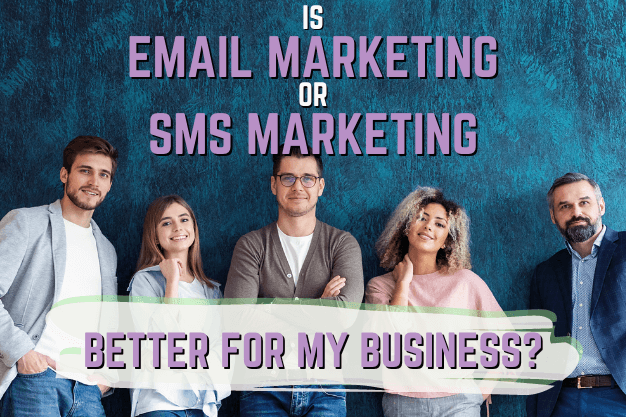For decades, email has been the preferred method for sending and receiving mass messages and reaching audiences. Text (or SMS) marketing, on the other hand, is a quick, cost-effective way to share promotions and updates with customers. So, which reigns supreme?
SMS or email marketing?
To figure out which strategy is right for your business you need to consider factors like cost, click-through rate (CTR), conversion rate, level of engagement, open rate, and ROI – just to name a few.
In this article, we will break down the differences between SMS marketing and email marketing. We’ll explain each strategy and demonstrate how they work, their benefits and drawbacks, when to use them, and whether you should hire the services of a digital agency for help.
So What Exactly Is Email Marketing?
Email marketing is mass-sending emails to people (leads or customers) on your e-mail list. The people on your list have chosen to be there. You send emails to inform current and prospective customers about new products, services, discounts, and special offers. Consider it a direct method of communicating with your customers in which you have their permission to send them promotional information. Your email list should be one of your most valuable business assets.

The Benefits and Drawbacks of Email Marketing
Every day, approximately 306.4 billion emails are sent. Email marketing is an important part of any business, and it works best for delivering more detailed information. It also has a much higher ROI than many other marketing channels and is quite versatile. An email campaign can be used for product updates, subscriptions, and promotions.
Here’s why you should use email marketing:
- It is reasonably priced – With a $40 profit for every $1 spent on email marketing, it’s still the best ROI in the game for over 2 decades.
- Emails can be personalized to the recipient – Any reputable email marketing expert will tell you that this feature enables you to connect with your audience, thereby increasing the email marketing conversion rate.
- The versatility of email is unlike any other marketing tool – You can use emails to provide detailed product information, make brief announcements, send reminders, welcome new customers, announce special offers, follow up with leads, or simply say hello to your target audience.
- It plays on user habits and intent – 44% of consumers check their emails at least once per day. People open emails with specific intentions, such as looking for updates, product information, customer service, and so on. This is why email marketing is so important.
- Emails are an excellent way to increase traffic to your website – You can increase the number of website site visitors looking for your products or services by using targeted email marketing services. Using targeted traffic increases the ROI of email marketing.
The cons of email marketing:
- A crowded inbox makes it difficult to capture the attention of your consumer – Every day, we all receive approximately 121 emails. When consumers sort through those emails daily, it’s easy to put everything in the spam folder. In many cases, your emails will end up in the same folder as spam.
- Emails can be prevented from inboxing – Email servers now have sophisticated filters. If your email appears to be spam, it may be blocked from reaching your recipient’s inbox. Any reputable digital agency can assist you in crafting emails that are more likely to reach your target audience’s inbox.
- People can easily delete or unsubscribe from emails – People may delete your emails or unsubscribe from your list for any reason like if they see messed-up graphics, poorly written headlines, unreadable text, or blocked images or content that isn’t relatable to them.

What Exactly Is SMS Marketing?
SMS marketing is the use of text messages to communicate with customers. SMS, like email marketing, is used to inform your audience about promotions, campaigns, updates, news, and more.
Before sending any promotional information, both SMS and email marketing ask for your audience’s permission. The CAN-SPAM Act and the Consumer Protection Act are the primary laws that protect consumers from unsolicited SMS (TCPA). These rules and guidelines are followed by all good SMS marketing examples.
SMS and email marketing are both owned channels. This means you can choose who receives your emails or text messages. It also means you have control over the type of user experience your customers will have.
You can send the SMS marketing examples listed below:
- Promotional SMS: These are SMS messages that are intended to raise brand awareness, promote products or services, and boost sales.
- Transactional SMS: These are text messages that contain information that your customers require, such as delivery updates, product specifications, and order information.
SMS Marketing’s Benefits and Drawbacks
When comparing SMS marketing to email marketing, SMS has the advantage of capturing the recipient’s attention right away. When you receive a text message, your phone alerts you, capturing your full and undivided attention right then and there. This is why the open rate for SMS marketing is higher than the open rate for email marketing.
This sense of urgency created by the alert is both a benefit and a disadvantage for SMS marketing. On the one hand, it may compel your customers to act immediately in response to your promotion. However, if sent at the wrong time, these texts can turn off users, who will either ignore or delete them.
Let’s go over the specific benefits and drawbacks of SMS marketing.
Here are some of the benefits of SMS marketing:
- Your customers do not require internet – It’s worth noting that 15% of Americans (52 million people) today have little or no internet access. This is a massive market that is beyond the scope of any email campaign.
- It has a better response rate – On average, text messages are read in three minutes. That’s a response rate of up to 209 percent when compared to social media, email, or even phone calls.
- It has a high level of engagement – SMS, like email marketing, is a marketing channel with higher levels of engagement than other lead generation strategies. Higher engagement levels suggest a higher SMS open rate.
Here are some of the drawbacks of SMS marketing:
- It has a limited amount of content space – You have only 160 characters to work with. Delivering powerful messages that are short while still packing a punch requires a pretty big vocabulary.
- It’s more expensive – The cost of running an SMS campaign is higher than the cost of running an email campaign.
- It may erode customer trust – Customers can easily lose trust with businesses that send them unwanted text messages or SMS that are poorly structured. Customers may become irritated if you send text messages at inconvenient or inappropriate times and It may also cause them to opt-out.

What Is the Difference Between SMS and Email Marketing?
Which is better: SMS marketing or email marketing? Think about the following:
| SMS | ||
|
Open Rate
|
98 percent | 20 percent |
|
CTR
|
29 percent | 2.5 percent |
|
Engagement
|
High | High |
|
Cost
|
5 to 15 cents per SMS (usually sent to thousands of recipients) |
Monthly costs range from $9 to $1,000 a month |
|
Av. response rate
|
90 seconds | 90 minutes |
|
SPAM Received
|
Less than three percent | Nearly 85 percent is considered spam |
| Message length | 160 characters | As long as you need |
|
ROI
|
$5 for every $1 spent | $40 for every $1 spent |
|
Frequency
|
There are currently fewer companies running SMS marketing campaigns | Email marketing has been around for decades and the market is saturated |
One of the first things marketers notice is that the ROI of email marketing is higher than that of SMS marketing. This suggests that the conversion rate for email marketing is also higher.
These are the figures that email marketing companies will provide you with. The lower email marketing open rate, on the other hand, proves the case for SMS marketing. Text messages also have a significantly higher CTR and response rate.
The Answer: Omnichannel Marketing
Omnichannel marketing is the use of multiple marketing channels to increase your bottom line. Your business has unique needs, so balancing SMS and email marketing is recommended for better results. You have a better chance of capturing your audience’s attention if you develop a marketing strategy that uses both in tandem.
When should SMS marketing be used? It should be used to respond to customer questions, solicit feedback, promote one of your products, and collect signups for your programs. Keeping track of its usage allows you to stay within your marketing budget.
Email marketing, on the other hand, is better suited to promoting multiple products due to its lower cost. It can be used for company updates, newsletters, and a variety of marketing emails.
Working With a Seasoned Digital Marketing Agency
Finding the right balance between SMS and email marketing can be difficult, especially if you haven’t had much success with either. If you are looking to improve your SMS and email marketing results, connect with us today. We can help you create a customized omnichannel plan based on your budget and goals. Contact us to learn more!

